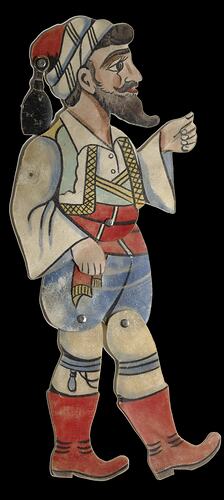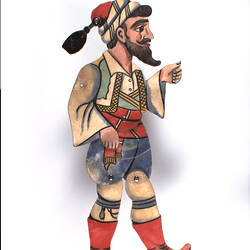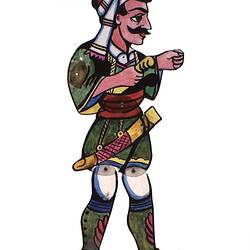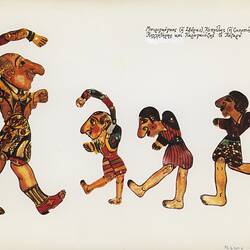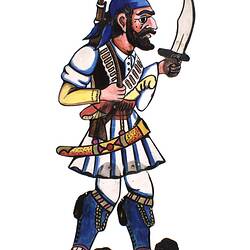Summary
Alternative Name[s]: Tselembis
This puppet was made in the 1960s by the Greek puppeteer and popular artist Abraam (Antonakos) in his Athens workshop, and by Dimitri Katsoulis. Abraam used it in performances in Greece during the 1960s. This and most of the puppets in the collection were brought to Australia by Abraam Antonakas for his performances at the Astor Theatre in Melbourne in 1977. He then left the collection with Dimitri Katsoulis who used them in all his subsequent performances in Victoria and in South Australia from 1978 to 1991.Dimitri did the preparation (designing the 5 leather pieces which constitute the puppet, cutting them with the scissors, scraping the surface to make it opaque). Then the colour was applied by Abraam, and after the colours set on the leather, he put the pieces together and brought the puppet onto the stage at his very next performance. Dimitri Katsoulis migrated to Australia in 1974 to escape a regime that repressed Greek artists. He had trained in Greece with theatre and film companies as an actor and technician. A master of the traditional Greek shadow puppet theatre, his performances explored contemporary issues such as the isolation of migrant women and children. Unable to obtain funding and support, he returned to Greece in 1991, leaving his entire collection to the people of Victoria. It includes 32 shadow puppets and around 170 props, set backdrops and technical tools and stage equipment. Dimitri has since returned to Melbourne and assists the Museum to continue to document this rich art form within both local and international contexts.
Hatziavatis is a character in the centuries-old Greek Shadow Puppet Theatre (Karaghiozis) tradition. Even though he is the complete opposite (in character) to Karaghiozis they are inseparable friends. Hatziavatis is servile and a typical compromiser. He is a flatterer, timid, cunning and has his own self-interest at heart. He is usually the cause of the beatings of which Karaghiozis is the recipient, so before embarking upon another scam concocted by Hatziavatis, Karaghiozis usually gives him his share of the beatings in advance, which Karaghiozis knows he is sure to receive. Hatziavatis appears in all the plays in Greek Shadow Puppet Theatre. Hatziavatis, is a primary puppet which is used by all the puppeteers and always idenitied by the same name.
The puppet is manipulated by a puppet rod [there are many examples in the collection] mounted at the top of its shoulder.
Information supplied by Greek Shadow Puppet Theatre master Dimitri Katsoulis, 2007.
Physical Description
A two-dimensional figure of a man, in profile, jointed at waist and above the knees. The figure is reversible. He wears a red and white tasseled cap, a white shirt, short braided jacket, red sash, blue bloomers and red boots. The tassel on the cap is jointed. There is a hole in one arm to attach the supporting rod. The man is bearded. The figure is made from painted leather.
Significance
This collection of puppets, props, stage sets, and technical tools and equipment relating to traditional Greek Shadow Puppet Theatre is unique in Australia and rare in international public collections. The history of Greek Shadow Puppet Theatre, its puppet characters and the methodology of its performance has been recorded in partnership with the puppet master to whom the collection belonged. The collection is highly significant both as documentation of an important cross-cultural, centuries-old art form, and as an example of the transnational migration of cultural activity between Greece and Australia. It is a collection which was created and performed in Greece and Australia from the mid to late twentieth century, by two puppet masters, who transported the tradition between two countries. Abraam Antonakos came to Australia in 1977 to perform the puppet theatre and then deposited the puppets with Dimitri Katsoulis, who had migrated to Australia in 1974. Dimitri's story becomes one of migration experience, cultural maintenance and adaptation, and finally return migration and the discontinuance of this cultural art form in Australia.
More Information
-
Collection Names
-
Collecting Areas
-
Acquisition Information
Purchase
-
Artist
-
User
Mr Abraam Antonakos, Athens, Greece, 1960-1977
Abraam made the puppet in Greece, and used it in performances during the 1960s and 1970s; and then in Victoria in 1977. -
User
Mr Abraam Antonakos, Victoria, Australia, 1977
Abraam made the puppet in Greece, and used it in performances during the 1960s and 1970s; and then in Victoria in 1977. -
User
Mr Dimitri Katsoulis, Australia, 1978-1991
Dimitri was given the puppet by Abraam in 1977 and then used it in his performances in Australia until 1991. -
Medium
Ink
-
Support
Plastic
-
Classification
-
Category
-
Discipline
-
Type of item
-
Overall Dimensions
24 cm (Length), 61.5 cm (Height)
-
References
[Link 1] Malkin, Michael, R. Traditional and Folk Puppets of the World, A.S. Barnes & Co., Inc., N.J., 1977; Simmen, Rene, The World of Puppets, Elsevier, Phaidon, London, 1975; Hogarth, Ann & Bussell, Jan, Fanfare for Puppets!, David & Charles Publishers Ltd, USA, 1985; Yayannos, A & Ar and Dingli, J. The World of Karaghiozis, 1976
-
Keywords
Cultural Maintenance, Greek Communities, Greek Immigration, Karaghiozis Theatre, Shadow Puppetry, Theatres, Working Life
